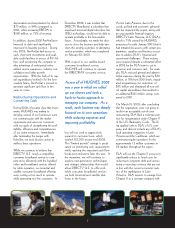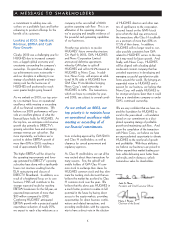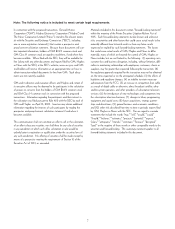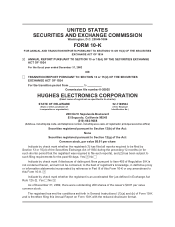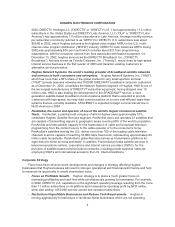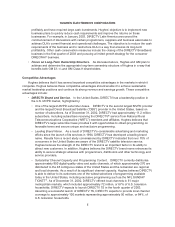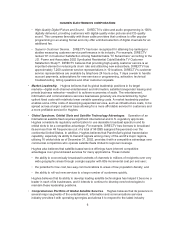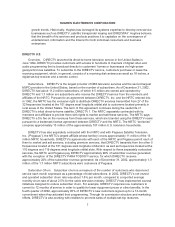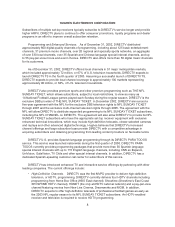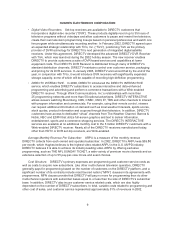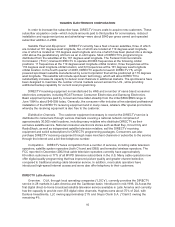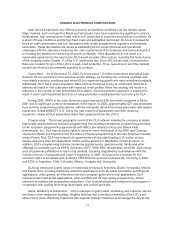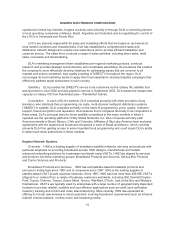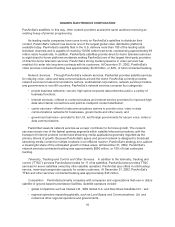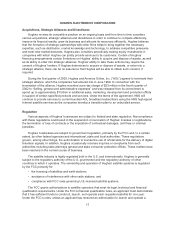DIRECTV 2002 Annual Report Download - page 17
Download and view the complete annual report
Please find page 17 of the 2002 DIRECTV annual report below. You can navigate through the pages in the report by either clicking on the pages listed below, or by using the keyword search tool below to find specific information within the annual report.HUGHES ELECTRONICS CORPORATION
growth trends. Historically, Hughes has leveraged its systems expertise to develop new service
businesses such as DIRECTV, satellite transponder leasing and DIRECWAY. Hughes believes
that the breadth of its services and products positions it to capitalize on the convergence of
entertainment, information and the Internet for both individual consumers and business
enterprises.
DIRECTV U.S.
Overview. DIRECTV launched its direct-to-home television service in the United States in
June 1994. DIRECTV provides customers with access to hundreds of channels of digital video and
audio programming that is broadcast directly to customers’ homes or businesses via high-power
geosynchronous satellites. To subscribe to the DIRECTV service, customers purchase or lease the
receiving equipment, which, in general, consists of a receiving dish antenna as small as 18 inches, a
digital set-top receiver and a remote control.
Subscribers. DIRECTV is the largest provider of DBS television services and the second largest
MVPD provider in the United States, based on the number of subscribers. As of December 31, 2002,
DIRECTV had about 11.2 million subscribers, of which 9.5 million are owned and operated by
DIRECTV and 1.7 million are subscribers who receive the DIRECTV service from the members and
affiliates of the NRTC. Pursuant to an agreement between DIRECTV, Inc. and the NRTC entered into
in 1992, the NRTC has the exclusive right to distribute DIRECTV services transmitted from 27 of the
32 frequencies located at the 101 degree west longitude orbital slot to customers located primarily in
rural areas of the United States. The term of this agreement continues during the useful life of
DIRECTV’s initial direct-to-home satellite, DIRECTV 1. The NRTC separately contracted with its
members and affiliates to provide them with rights to market and sell these services. The NRTC pays
DIRECTV a 5% fee on the revenues from these services, which are branded using the DIRECTV name
pursuant to a trademark license agreement between DIRECTV and the NRTC. The NRTC “territories”
comprise approximately 13 million of the approximately 107 million U.S. television households.
DIRECTV has also separately contracted with the NRTC and with Pegasus Satellite Television,
Inc. (“Pegasus”), the NRTC’s largest affiliate whose territory covers approximately 11 million of the 13
million NRTC households. DIRECTV’s agreements with each of the NRTC and Pegasus permit each of
them to market and sell services, including premium services, that DIRECTV transmits from the other 5
frequencies located at the 101 degrees west longitude orbital slot, as well as frequencies located at the
110 degrees and 119 degrees west longitude orbital slots. With respect to these separately contracted
services, the NRTC and Pegasus pay DIRECTV approximately 90% of subscriber revenue generated,
with the exception of the DIRECTV PARA TODOSTM service, for which DIRECTV receives
approximately 20% of the subscriber revenue generated. As of December 31, 2002, approximately 1.3
million of the 1.7 million NRTC subscribers were customers of Pegasus.
Subscriber Churn. Subscriber churn is a measure of the number of customers who disconnect
service each month expressed as a percentage of total subscribers. In 2002, DIRECTV’s net owned
and operated subscriber churn rate was about 1.6% per month, compared to a reported average
monthly churn rate of about 2.5% for the cable television industry. DIRECTV has implemented several
initiatives designed to reduce subscriber churn. For example, DIRECTV requires new customers to
commit to 12 months of service in order to qualify for lower equipment prices or other benefits. In the
fourth quarter of 2002, approximately 95% of DIRECTV’s new customers signed up for a 12-month
commitment when they activated their programming. Through its commission structure and marketing
efforts, DIRECTV is also working with retailers to promote sales of multiple set-top receivers.
7


